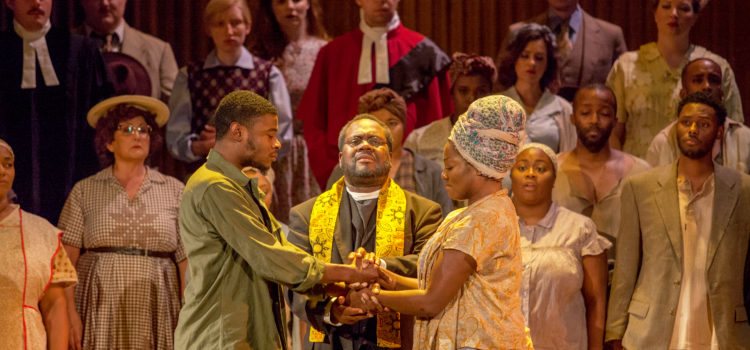By Lynn Venhaus
Managing Editor
As comforting as a cup of cocoa, “A Christmas Story” is bathed in the golden glow of nostalgia, evoking warm and amusing childhood memories of Christmases past.
The Repertory Theatre of St. Louis is staging a merry and bright new version of the play by Philip Grecian, which is based on the 1983 perennial holiday film favorite. The film’s narrator, Jean Shepherd, co-wrote the screenplay with director Bob Clark and Leigh Brown, and for the past 45 years, has struck a multi-generational chord with folks happy to remember what it was like to be a kid at Christmas.
A popular American humorist, Shepherd grew up in Hammond, Indiana, in the 1920s – 30s, and the Parker Family’s story was shaped from his 1966 semi-autobiographical anecdotal book, “In God We Trust: All Others Pay Cash.”
A storyteller, writer, radio host and actor, Shepherd was known for his astute observations on ordinary life. The Rep’s sentimental production capitalizes on the shared connections we have about our families, our neighborhoods, school days and the moments that shape our lives.
Charlie Mathis and Ted Deasy in the Repertory Theatre of St. Louis’ production of “A Christmas Story” at the Loretto-Hilton Center. ©Photo by Jerry Naunheim Jr.Who doesn’t remember yearning for a gift one year that you were ecstatic to get above all others? We could relate to 9-year-old Ralphie’s desire for a Red Ryder BB gun, and how exasperating his traditional nuclear family was to him.
No matter how familiar you are with this story, the resonating moments remain as plentiful as the first few times you saw the film. The movie went nowhere in 1983 – and I was one of those rare viewers who saw it then at the cinema – but it didn’t catch fire until its VHS release, then cable television elevated it to exalted classic status.
The memorable highlights received hearty reactions on stage – the pink bunny pajamas, the frozen tongue on the flagpole, the department store Santa visit, the roasted turkey for the Christmas feast and the prize “leg” lamp.
We expect to laugh. You’re smiling right now reading this, aren’t you?
And the cast solidly immerses us into that corner of small-town America. Yet, even though the story is beloved, The Rep doesn’t take your interest for granted – director Seth Gordon earns it. After all, he knows this material well – he helped Grecian develop the play between 2005 and 2010, with the playwright sharpening the characters and tightening the story. He has directed the show six times (but not the one first here in 2009), and still has a twinkle in his eye.
The jolly ensemble fully creates a believable working-class Midwestern family and townsfolk, crisply delivering this well-worn memory piece with an enthusiastic freshness.
The narrator is now the adult Ralphie, and Ted Deasy, who was a cynical lawyer in last spring’s “Born Yesterday,” is bursting with excitement to share the vivid details of his boyhood. It’s through his wide eyes we see these daffy misadventures, as he glides through their modest home.
Jerry Naunheim Jr. PhotoLaurel Casillo brings some spunk and cheeriness as Mother and Brad Fraizer is funny as the grumpy Old Man, full of bark and bluster but really a softie. They are affectionate portraits with roots in reality.
Endearing Charlie Mathis, quite memorable as Dill in last year’s “To Kill a Mockingbird,” is delightful as young Ralphie, getting in one jam after another, but also disappearing into a robust fantasy life, whether he’s confronting Black Bart or imagining he’s dead.
Mathis’ timing is impeccable, and he interacts nicely with his best buddies (Dan Wolfe as Flick, Rhadi Smith as Schwartz), his parents and goofy brother Randy (Spencer Slavik).
Tanner Gilbertson makes an impressive debut as the dreaded bully Scut Farkus, while Gigi Koster and Ana McAlister are sweet as the schoolgirls Helen and Esther Jane. Jo Twiss is the feared elementary teacher Miss Shields.
Gordon has worked very well with the youngsters, fluidly guiding them and creating room to play — not too sweet or artificial, not trying too hard, and without any nerves showing.
Their ease helps us stroll memory lane in the neighborhood. Scenic Designer Michael Ganio’s exquisitely detailed home uses an effective brown color palette for a typical two-story home, but when the department store is revealed, he has pulled out all the stops. It’s a shimmering winter wonderland, benefitting from Peter Sargent’s outstanding lighting design, and Rusty Wandall’s sound.
Costume Designer David Kay Mickelson has fashioned vintage outfits that accurately reflect the time and season. And oh, what fun to recall those layers of wool, knits and outdoorswear that every kid was forced to bundle up in back in the day.
Tapping into childlike wonder and celebrating cherished special-occasion memories is enjoyable. The Rep’s “A Christmas Story” allows us to pause and reflect on the magic of the season from a child’s perspective. It’s up to us to keep it in our hearts when the season’s long over.
“A Christmas Story” will be presented at The Repertory Theatre of St. Louis’ mainstage from Nov. 30 to Dec. 22. Tickets are on sale at the www.repstl.org or by phone at 314-968-4925 or in-person at The Rep box office, which is located at 130 Edgar Road, on the campus of Webster University. For more information about the show, visit www.repstl.org/a-christmas-story
TUESDAY, NOV. 27, 2018 -This is the Repertory Theatre of St. Louis’ production of “A Christmas Story” at the Loretto-Hilton Center. ©Photo by Jerry Naunheim Jr.

Lynn (Zipfel) Venhaus has had a continuous byline in St. Louis metro region publications since 1978. She writes features and news for Belleville News-Democrat and contributes to St. Louis magazine and other publications.
She is a Rotten Tomatoes-approved film critic, currently reviews films for Webster-Kirkwood Times and KTRS Radio, covers entertainment for PopLifeSTL.com and co-hosts podcast PopLifeSTL.com…Presents.
She is a member of Critics Choice Association, where she serves on the women’s and marketing committees; Alliance of Women Film Journalists; and on the board of the St. Louis Film Critics Association. She is a founding and board member of the St. Louis Theater Circle.
She is retired from teaching journalism/media as an adjunct college instructor.


